Lyons W.C. (ed.). Standard handbook of petroleum and natural gas engineering.2001- Volume 1
Подождите немного. Документ загружается.


Compressors
485
Vertical
V-type W-type
Horizontal opposed
(Boxer
type)
Engine
or
Vertical with stepped piston
(Two-stagel
Integral L-type Integral W-type
Figure
3-71.
Single-acting (trunk-type) reciprocating piston compressor
[23].
In
line L-W.Ps
V-type W-type
Horizontal opposed Horizontal with stepped piston
(Four-stage)
Integral L-type
Figure
3-72.
Double-acting (crosshead-type) reciprocating piston compressor
[4].
around the periphery of each piston. These wear bands are made of special wear-
resistant dry lubricating materials such as polytetrafluorethylene. Trunk type
nonlubricated compressors have dry crankcases with permanently lubricated bearings.
Crosshead type compressors usually have lengthened piston rods
to
ensure that no
oil
wet parts enter the compression space
[4,25].
Most reciprocating compressors have inlet and outlet valves
(on
the piston heads)
that are actuated by a pressure difference. These are called
self-acting valves.
There
are
some
larger multistage reciprocating piston compressors that do have camshaft-
controlled valves with rotary slide valves.
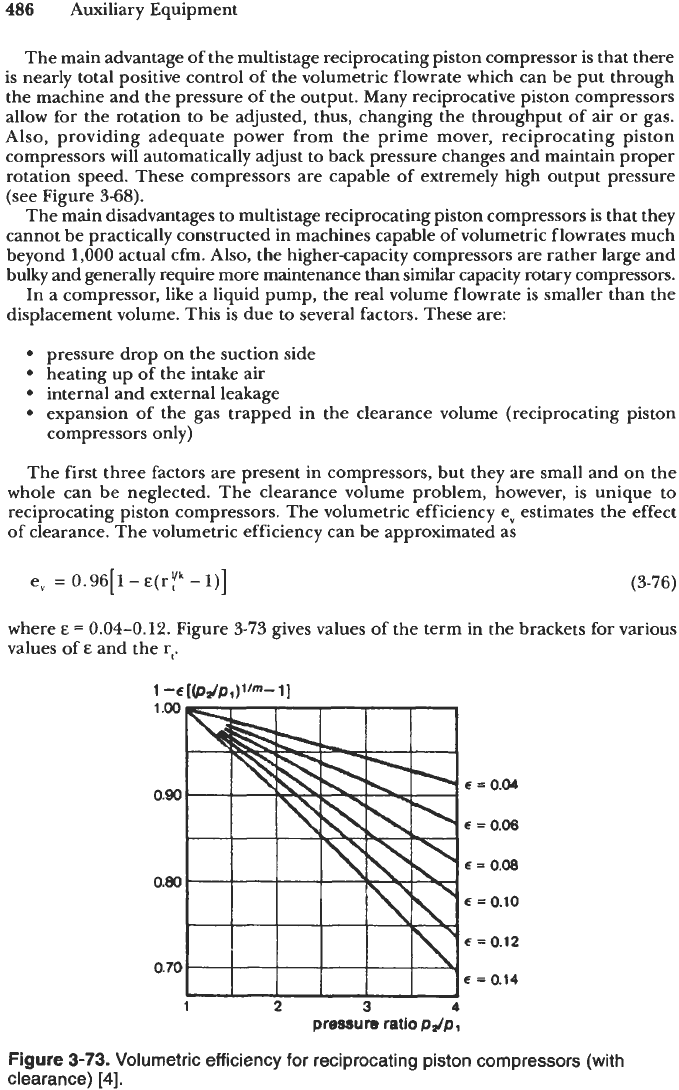
486
Auxiliary Equipment
The main advantage of the multistage reciprocating piston compressor is that there
is nearly total positive control of the volumetric flowrate which can be put through
the machine and the pressure of the output. Many reciprocative piston compressors
allow for the rotation to be adjusted, thus, changing the throughput
of
air
or
gas.
Also,
providing adequate power from the prime mover, reciprocating piston
compressors will automatically adjust to back pressure changes and maintain proper
rotation speed. These compressors are capable of extremely high output pressure
(see Figure
3-68).
The main disadvantages to multistage reciprocating piston compressors is that they
cannot be practically constructed in machines capable of volumetric flowrates much
beyond
1,000
actual cfm. Also, the highercapacity compressors are rather large and
bulky and generally
require
more maintenance
than
similar capacity rotary compressors.
In
a
compressor, like a liquid pump, the real volume flowrate is smaller than the
displacement volume. This is due to several factors. These are:
pressure drop on the suction side
heating up of the intake air
internal and external leakage
expansion of the gas trapped in the clearance volume (reciprocating piston
compressors only)
The first three factors are present in compressors, but they are small and on the
whole can be neglected. The clearance volume problem, however, is unique to
reciprocating piston compressors. The volumetric efficiency eV estimates the effect
of clearance. The volumetric efficiency can be approximated as
e,
=
0.96[1-
E(rf
-
l)]
(3-76)
where
E
=
0.04-0.12.
Figure
3-73
gives values of the term in the brackets for various
values
of
E
and the
rt.
=
0.04
=
am
=
0.08
=
0.10
=
0.12
=
0.14
1
2
3
4
pressure
ratiopJp,
Figure
3-73.
Volumetric efficiency for reciprocating piston compressors
(with
clearance)
[4].
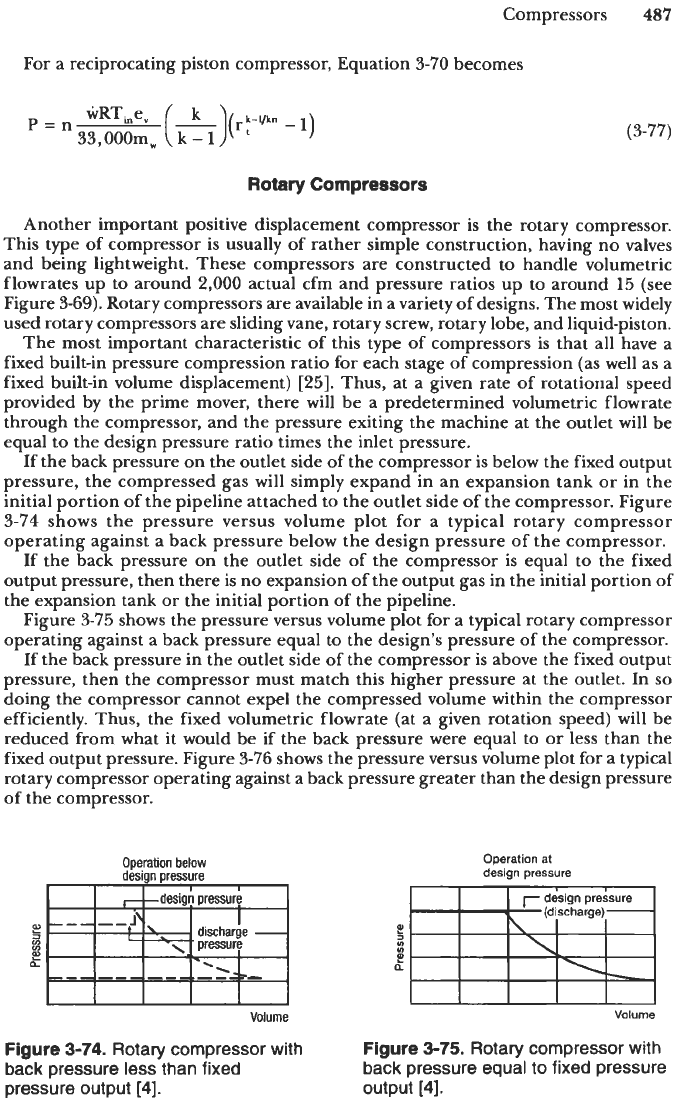
Compressors
487
For a reciprocating piston compressor, Equation
3-70
becomes
(3-77)
Rotary
Compressors
Another important positive displacement compressor is the rotary compressor.
This
type
of compressor is usually of rather simple construction, having no valves
and being lightweight. These compressors are constructed to handle volumetric
flowrates up to around
2,000
actual cfm and pressure ratios up
to
around 15 (see
Figure
3-69).
Rotary compressors are available in a variety of designs. The most widely
used rotary compressors
are
sliding vane, rotary screw, rotary lobe, and liquid-piston.
The most important characteristic of this type of compressors is that all have a
fixed built-in pressure compression ratio for each stage of compression (as well as a
fixed built-in volume displacement)
[25].
Thus, at a given rate of rotational speed
provided by the prime mover, there will be a predetermined volumetric flowrate
through the compressor, and the pressure exiting the machine at the outlet will be
equal to the design pressure ratio times the inlet pressure.
If the back pressure on the outlet side of the compressor is below the fixed output
pressure, the compressed gas will simply expand in an expansion tank or in the
initial portion of the pipeline attached to the outlet side of the compressor. Figure
3-74
shows the pressure versus volume plot for a typical rotary compressor
operating against a back pressure below the design pressure of the compressor.
If the back pressure on the outlet side of the compressor is equal to the fixed
output pressure, then there is no expansion of the output gas in the initial portion of
the expansion tank or the initial portion of the pipeline.
Figure
3-75
shows the pressure versus volume plot for a typical rotary compressor
operating against a back pressure equal to the design's pressure of the compressor.
If the back pressure in the outlet side
of
the compressor is above the fixed output
pressure, then the compressor must match this higher pressure at the outlet. In
so
doing the compressor cannot expel the compressed volume within the compressor
efficiently. Thus, the fixed volumetric flowrate (at a given rotation speed) will be
reduced from what it would be
if
the back pressure were equal to or less than the
fixed output pressure. Figure
3-76
shows the pressure versus volume plot for a typical
rotary compressor operating against a back pressure greater than the design pressure
of the compressor.
operabion
below
desion
oresswe
Operation
at
design pressure
J-
design pressure
(discharge)
a
Volume
Volume
Figure
3-74.
Rotary compressor with
back pressure less than fixed
pressure output
[4].
output
[4].
Figure
3-75.
Rotary compressor with
back pressure equal to fixed pressure

488
Auxiliary Equipment
Vdumo
Figure
3-76.
Rotary compressor with back pressure greater
than
fixed pressure
output.
Nearly all rotary compressors can be designed with multiple stages. Such multistage
compressors are designed with nearly equal compression ratios for each stage. Thus,
since the volumetric flowrate (in actual cfm) is smaller from one stage to the next,
the volume displacement
of
each stage is progressively smaller.
Sliding Vane Compressor
The typical sliding vane compressor stage is a rotating cylinder located eccentrically
in the bore of a cylindrical housing (see Figure
3-77).
The vanes are in slots in the
rotating cylinder, and are allowed to move in and out
of
these slots to adjust to
the changing clearance between the outside surface of the rotating cylinder and the
inside bore surface of the housing. The vanes are always in contact with the inside
bore due
to
either air pressure under the vane, or spring force under the vane. The
Figure
3-77.
Sliding
vane compressor
[25].

Compressors
489
top of the vanes slide over the inside surface of the bore of the housing as the inside
cylinder rotates. Gas is brought into the compression stage through the inlet suction
port. The gas is then trapped between the vanes, and as the inside cylinder rotates
the gas is compressed to a smaller volume as the clearance is reduced. When the
clearance is the smallest, the gas has rotated to the outlet port. The compressed gas
is discharged to the pipeline system connected to the outlet side of the compressor.
As each set of vanes reaches the outlet port, the gas trapped between the vanes is
discharged. The clearance between the rotating cylinder and the housing is fixed,
and thus the pressure ratio of compression for the stage is fixed,
or
built-in. The
geometry, e.g., cylinder length, diameter, etc., of the inside of each compressor stage
determines the displacement volume and compression ratio of the compressor.
The principal seals within the sliding vane compressor are provided by the
interface between the end of the vane and the inside surface of the cylindrical
housing. The sliding vanes must be made of a material that will not damage the
inside surface of the housing. Therefore, most vane material is phenolic resin-
impregnated laminated fabrics (such as asbestos
or
cotton cloth). Also, some metals
other than one that would gall with the housing can be used such as aluminum.
Usually, vane compressors utilize oil lubricants in the compression cavity to allow
for smooth action of the sliding vanes against the inside of the housing. There
are, however, some sliding vane compressors that may be operated oil-free. These
utilize bronze,
or
carbon/graphite vanes
[25].
The volumetric flowrate for a sliding vane compression stage
q,
(ft”/min) is
approximately
q,
=
2al (d,
-
mt)N
(3-78)
where a is the eccentricity in ft,
1
is the length of the cylinder in ft, d, is the outer
diameter of the rotary cylinder in ft,
4
is the inside diameter of the cylindrical housing
in ft, t is the vane thickness in ft, m is the number of vanes, and
N
is the speed of the
rotating cylinder in rpm.
The eccentricity a is
a=- d,
-
d,
2
(3-79)
Some typical values of a vane compressor stage geometry are dJd,
=
0.88,
a
=
0.06d2,
a
=
0.06d2, and l/d,
=
2.00 to
3.00.
Typical vane up speed usually does not exceed
50
ft/s.
There is no clearance in a rotary compressor. However, there is leakage
of
air
within the internal seal system and around the vanes. Thus, the typical volumetric
efficiency for the sliding vane compression
is
of the order
of
0.82
to
0.90.
The heavier
the gas, the greater the volumetric efficiency. The higher the pressure ratio through
the stage, the lower the volumetric efficiency.
Rotary
Screw
Compressor
The typical rotary screw compressor stage is made up of two rotating shafts, or
screws. One is a female rotor and the other a male rotor. These two rotating
components turn counter
to
one another (counterrotating). The two rotating elements
are designed
so
that as they rotate opposite to one another; their respective helix
forms intermesh (see Figure
3-78).
As
with all rotary compressors, there are no valves.
The gas is sucked into the inlet post and is squeezed between the male and female
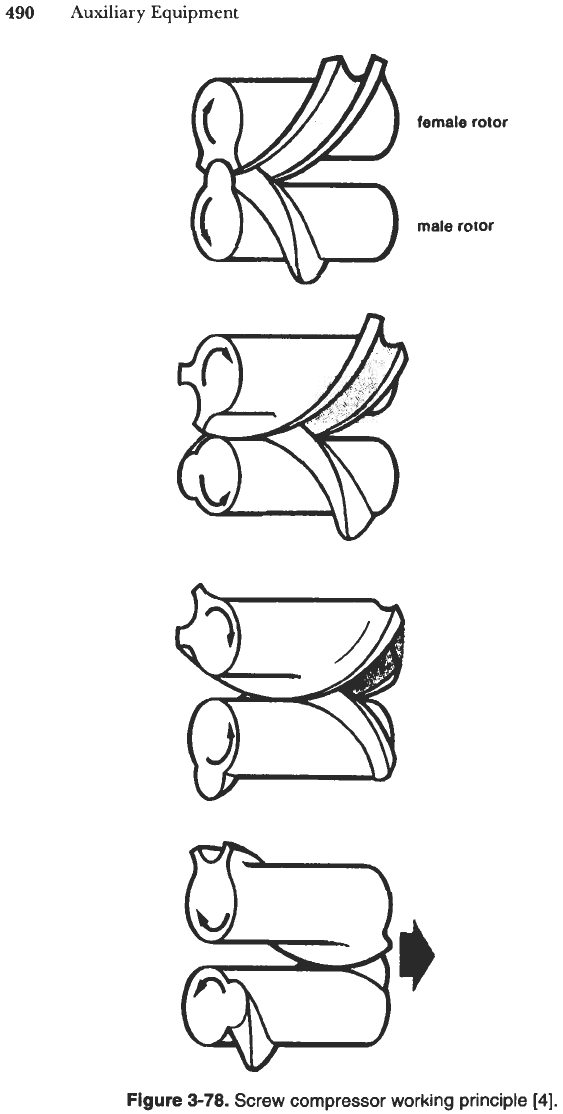
490
Auxiliary
Equipment
female
rotor
male
rotor
Figure
3-78.
Screw compressor working principle
[4].
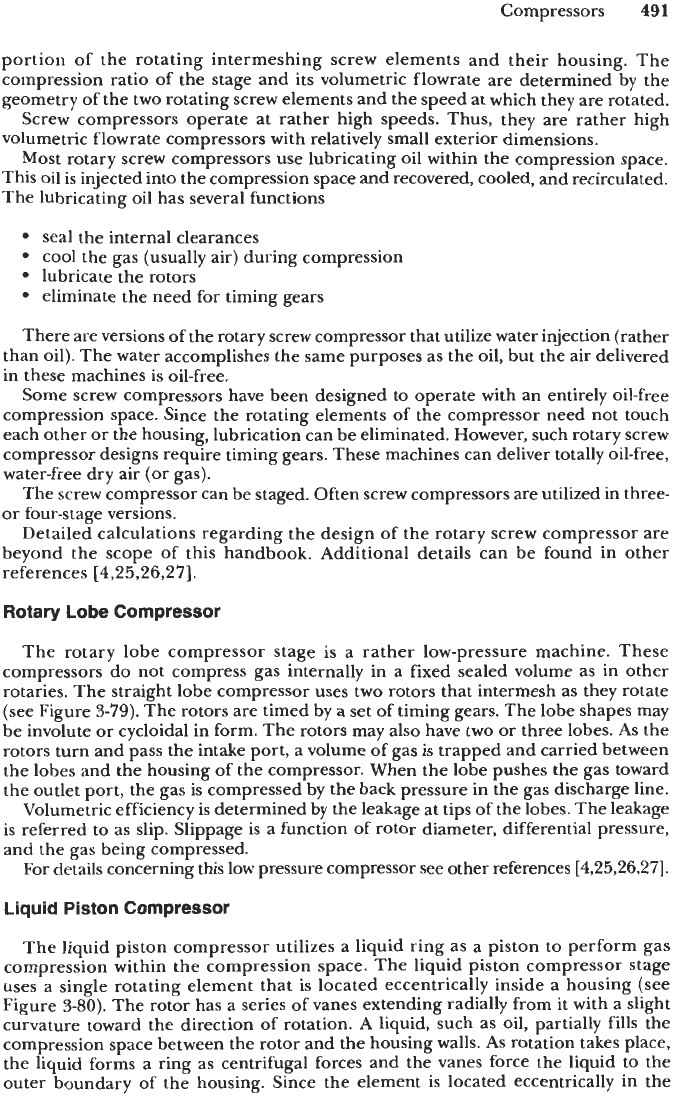
Compressors
491
portion of the rotating intermeshing screw elements and their housing. The
compression ratio of the stage and its volumetric flowrate are determined by the
geometry of the two rotating screw elements and the speed at which they are rotated.
Screw compressors operate at rather high speeds. Thus, they are rather high
volumetric
f
lowrate compressors with relatively small exterior dimensions.
Most rotary screw compressors use lubricating
oil
within the compression space.
This oil is injected into the compression space and recovered, cooled, and recirculated.
The lubricating oil has several functions
seal the internal clearances
cool the gas (usually air) during compression
lubricate the rotors
eliminate the need for timing gears
There are versions
of
the rotary screw compressor that utilize water injection (rather
than oil). The water accomplishes the same purposes as the oil, but the air delivered
in these machines is oil-free.
Some screw compressors have been designed to operate with an entirely oil-free
compression space. Since the rotating elements of the compressor need not touch
each other or the housing, lubrication can be eliminated. However, such rotary screw
compressor designs require timing gears. These machines can deliver totally oil-free,
water-free dry air (or gas).
The screw compressor can be staged. Often screw compressors are utilized in three-
or four-stage versions.
Detailed calculations regarding the design of the rotary screw compressor are
beyond the scope
of
this handbook. Additional details can be found in other
references
[4,25,26,27].
Rotary
Lobe
Compressor
The rotary lobe compressor stage
is
a rather low-pressure machine. These
compressors do not compress gas internally in a fixed sealed volume as in other
rotaries. The straight lobe compressor uses two rotors that intermesh as they rotate
(see Figure
3-79).
The rotors are timed by a set of timing gears. The lobe shapes may
be involute or cycloidal in form. The rotors may also have two or three lobes.
As
the
rotors turn and pass the intake port, a volume of gas is trapped and carried between
the lobes and the housing
of
the compressor. When the lobe pushes the gas toward
the outlet port, the gas is compressed
by
the back pressure in the gas discharge line.
Volumetric efficiency is determined by the leakage at tips
of
the lobes. The leakage
is referred to as slip. Slippage is a function of rotor diameter, differential pressure,
and the gas being compressed.
For details concerning this
low
pressure compressor see other references
[4,25,26,27].
Liquid
Piston
Compressor
The liquid piston compressor utilizes a liquid ring as a piston to perform gas
compression within the compression space. The liquid piston compressor stage
uses a single rotating element that is located eccentrically inside
a
housing (see
Figure
3-80).
The rotor has a series
of
vanes extending radially from it with a slight
curvature toward the direction
of
rotation. A liquid, such
as
oil, partially fills the
compression space between the rotor and the housing walls.
As
rotation takes place,
the liquid forms a ring as centrifugal forces and the vanes force the liquid to the
outer boundary of the housing. Since the element is located eccentrically in the
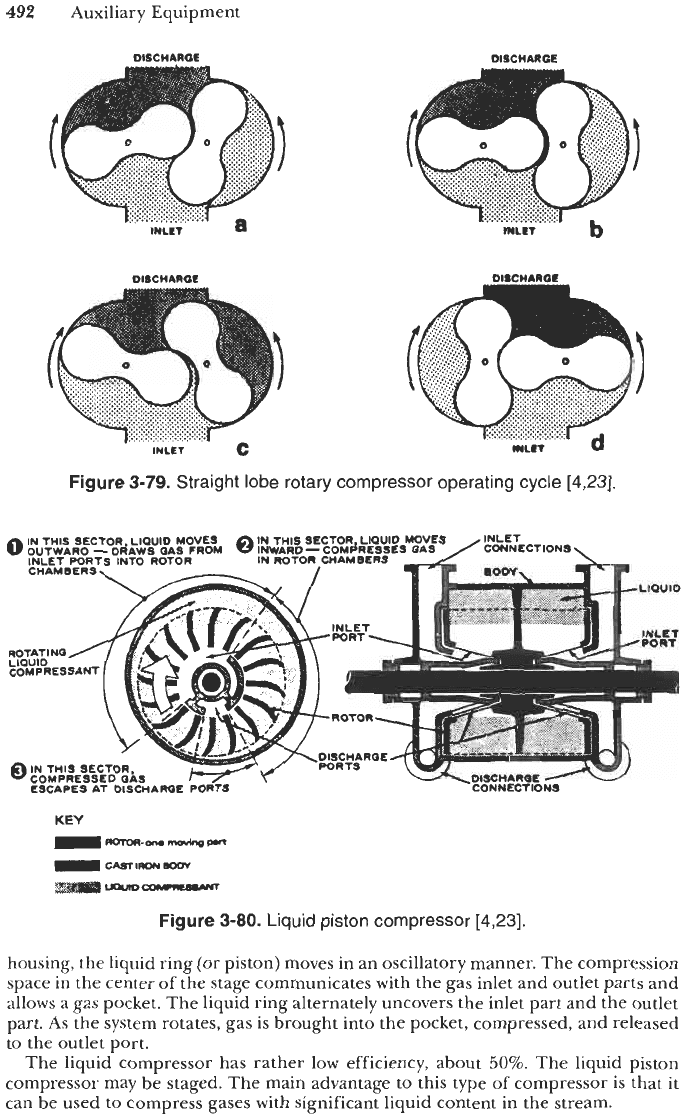
492
Auxiliary Equipment
Figure
3-79.
Straight lobe rotary compressor operating cycle
[4,23].
IN
tnis
SECTOR
Liauio
MOVES
IN
Tnis
s
0
OUTWARD
-
DdAWS
OAS
FROM
@
INWARD-
--....
.
IN ROTOR CHAM€
INLET
WRTS
INTO ROTOR
IN
THIS
SECT0
COMPRESSED QAS
ESCAPES AT DISCHARQL
Figure
3-80.
Liquid piston compressor
[4,23].
housing, the liquid ring (or piston) moves in an oscillatory manner. The compression
space in the center
of
the stage communicates with the gas inlet and outlet parts and
allows a gas pocket. The liquid ring alternately uncovers the inlet part and the outlet
part. As the system rotates, gas is brought into the pocket, compressed, and released
to the outlet port.
The liquid compressor has rather low efficiency, about
50%.
The liquid piston
compressor may be staged. The main advantage to this type of compressor is that it
can be used
to
compress gases with significant liquid content in the stream.

Compressors
493
Summary
of
Rotary Compressors
The main advantage of rotary compressors is that most are easy
to
maintain in
field conditions and in industrial settings. Also, they
can
be constructed to be rather
portable since they have rather small exterior dimensions. Also, many versions of the
rotary
compressor can produce oil-free compressed gases.
The main disadvantage
are
that these machines operate at a fued pressure ratio.
Thus, the cost of operating the compressor does not basically change with reduced
back pressure in the discharge line.
As
long as the back pressure is less than the
pressure output
of
the rotary, the rotary will continue to operate at a fixed power
level. Also, since the pressure ratio is built into the rotary compressor, discharging
the compressor into a back pressure near
or
greater than the pressure output of the
machine will significantly reduce the volumetic flowrate produced by the machine.
Centrifugal Compressors
The centrifugal compressor is the earliest developed dynamic,
or
continuous flow,
compressor. This type of compressor has no distinct volume in which compression
takes place. The main concept
of
the centrifugal compressor is use
of
centrifugal
force to convert kinetic energy into pressure energy. Figure
3-81
shows a diagram of
a single-stage centrifugal compressor. The gas to be compressed is sucked into the
center
of
the rotating impeller. The impeller throws the gas out
to
the periphery by
means of its radial blades and high-speed rotation. The gas is then guided through
the diffuser where the high-velocity gas is slowed, which results
in
a high pressure. In
multistage centrifugal compressors, the gas is passed to the next impeller after the
diffuser of the previous impeller. In this manner, the compressor may be staged to
OUT
Figure
3-81.
Single-stage
centrifugal
compressor
[23].

494
Auxiliary Equipment
increase the pressure of the ultimate discharge (see Figure
3-82).
Since the compression
pressure ratio at each stage is usually rather
low,
of the order
2
or
so,
the need for
intercooling is not important after each stage. Figure
3-82
shows a typical multistage
centrifugal compressor configuration with an intercooler after the first three stages
of compression.
The centrifugal compressor must operate at rather high rotation speeds to be
effective. Most commercial centrifugal compressors operate at speeds of the order of
20,000-30,000 rpm. With such rotation speeds very large volumes of gas can be com-
pressed with equipment having rather modest external dimensions. Commercial
centrifugal compressors can operate with volumetric flowrates up to around
10.4
actual cfm and with overall compression ratios up to about
20.
Centrifugal compressors are usually used in large processing plants and in some
pipeline applications. They can be operated with any lubricant or other contami-
nant in the gas stream, or they can be operated with some small percentage of
liquid in the gas stream.
These machines are used principally to compress large volumetric f lowrates to
rather modest pressures. Thus, their use is more applicable to the petroleum refining
and chemical processing industries.
More details regarding the centrifugal compressor may be found in other references
[4,231.
Axial-Flow
Compressors
The axial compressor is a very high-speed, large volumetric flowrate machine.
This is another dynamics, or continuous flow machine. This type of compressor
sucks in gas at the intake port and propels the gas axially through the compression
space via a series of radially arranged rotor blades and stator (diffuser) blades (see
Figure 3-83). As in the centrifugal compressor, the kinetic energy of the high-velocity
flow exiting each rotor stage is converted to pressure energy in the follow-on stator
(diffuser) stage. Axial-flow compressors have
a
volumetric flowrate range of about
3
x
104-106
actual cfm. Their compression ratio is typically around
10
to
20.
Because
OUT
Figure
3-82.
Multistage centrifugal compressor with intercooling
[23].
